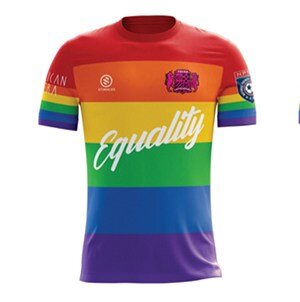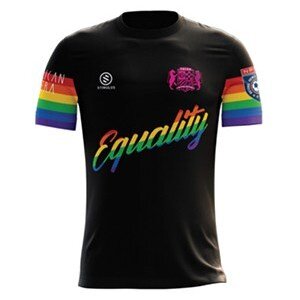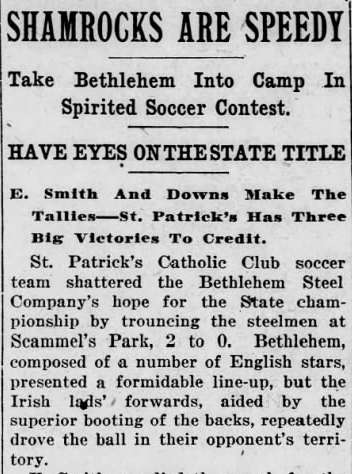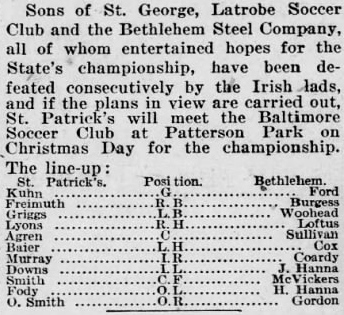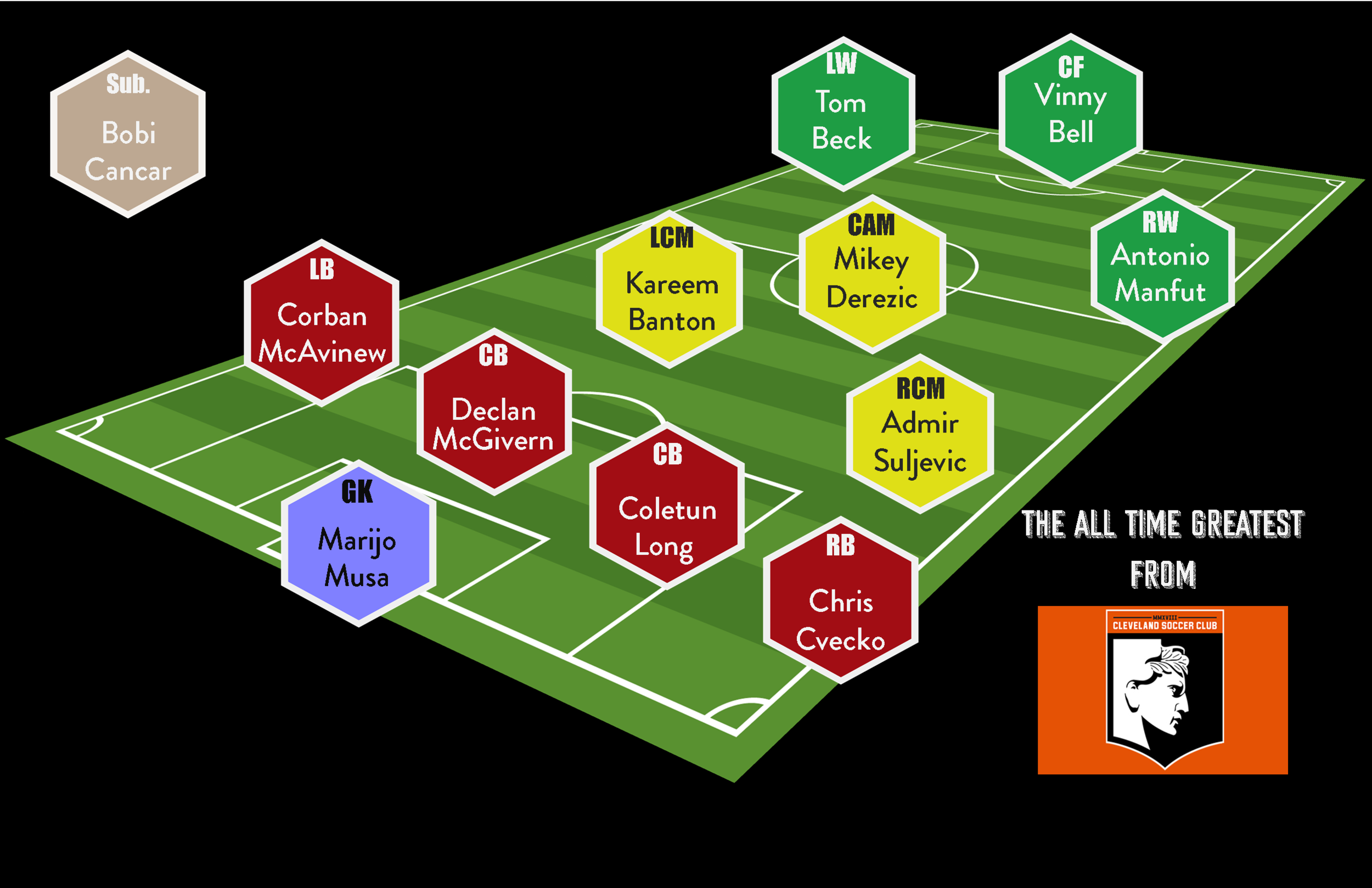Ryan's Weekend Recap
UPSL Action
Las Vegas Showcase
Heartland Super Cup
UPSL ACTION
FC Harrington 4 - 3 Real Irving CD
The weight of humidity that hung in the air on Friday night in Mansfield, Texas may have lulled the gathered fans into assuming that they were in for a sluggish match. FC Harrington and Real Irving CD quickly dispatched that notion with a high scoring tilt, kicked off by the visitors from Irving’s opening goal in just the second minute. Given a free kick along the left boundary roughly ten yards back of the midfield line, Real Irving drove a deep cross toward the center of the field, where the forward was just able to reach out a toe in a leaping effort for a magical touch that lifted the ball over the Harrington keeper into the top left corner of the goal. FC Harrington battled back, earning a chance with a penalty in the 20th minute, which league player of the week candidate Papa Ndoye deftly put away for the early equalizer. Real Irving would take the lead again in the 28th minute when a well-timed through pass was deflected by the outstretched foot of a Harrington defender, but fell fortuitously to the Irving forward, now 1 v1 with the Harrington goalkeeper. The forward coolly dribbled around the keeper’s diving effort before slotting home the score. A Real Irving cross from the right side of the attack to an unmarked teammate providing a strong header from directly in front of the net in the 35th minute extended the Real Irving lead to 3-1 at the half.The hosts returned for the second half clearly intent on dictating the pace of the match and controlling possession, displaying a more disciplined approach to their attacking play and a willingness to better spread the opposition across the pitch with patient movement of the ball both forward, and now increasingly backward and lateral, passing. The patience and discipline paid off for FC Harrington in the 66th minute when they dispossessed Real Irving along the left boundary and quickly flipped the field of play with a through ball down the line and a cross to Ndoye in center against spread-thin defense. Ndoye got a step on the one marked defender and drove a right-footed shot across his body and into the bottom left corner of the goal for his, and Harrington’s, second score of the night. Three minutes later, Real Irving would drop to ten men on a red card, and FC Harrington seized upon the numbers advantage with increased pressure, sensing the opportunity to equalize. They’d find it, in the 88th minute, again at the penalty spot, with Real Irving keeper guessing correctly on the placement of Ndoye’s attempt, but the FC Harrington forward’s shot was too quick for the keeper to reach in time and the score was now knotted at 3 goals apiece.
Given seven minutes of extra time, FC Harrington needed just two of those minutes to earn a corner, where Josh Irwin would beat his defender to meet the service from Francisco Vidal and drive an emphatic header home for the hosts’ fourth goal and their first lead of the night. The lead would hold for the final five minutes, and the newly double-promoted (from D3 to D2 after the Fall 2019 season, then to D1 due to Covid-19 attrition) FC Harrington claimed both the win and, for now, the top spot in UPSL’s Central Conference - North, Division One.
Leg AZ Soccer International 1 - 1 Orlando Rovers
LAZSI couldn’t pull away from a game Rovers side in Orlando in their season opener, leaving the sides splitting points and huddled together near the bottom of the pack in the Southeast Conference - Florida Central East, Division One standings.
OFC Barca 7 - 1 Royal Palms SC
It continues to be a rough welcome to the league for the newcomers from Palm Coast as Royal Palms SC couldn’t find any answers defensively for OFC Barca’s player of the week nominee Victor Rojas’ four goals, falling in a very lopsided loss and claiming sole possession of the bottom of the conference standings.
Clay County SC 2 - 1 Macca Ballers FC
The North Florida outlier this season in a Central Florida dominated conference, Jacksonville-suburb-based Clay County SC came away with three points in the season opener between them and Macca Ballers FC.
Diaspora United CC 3 - 3 Celta Gunners
Diaspora United avoided opening their first season in the league with three straight losses by surviving a high scoring competition from Celta Gunners to claim a draw. The Gunners now have two ties on the season and will have to wait til next week to see if they can get a conference victory.
Sporting Orlando 4 - 2 FK Orlando
Player of the Week award winner Vander Lee paced his Sporting Orlando side Saturday evening, scoring three of his club’s four goals. Sporting would each and every one of those scores, as the Central Florida league stalwarts found expansion club FK Orlando a worthy opponent in a high scoring match.
Athletic Houston FC 4 - 0 Texas Hawks
Athletic Houston played spoiler in the Texas Hawks’ season opener, gifting their intra-city rival with a -4 goal differential a place at the bottom of the standings after a dominant display at Campbell Road Sports Park.
Barcelona School of Excellence 2 - 6 Houston FC
Barcelona School of Excellence played Athletic Houston to a confidence-building draw the previous week, but they’ll be searching for that confidence well again this week after hosting Houston FC at the Farm League Field. The visitors, lead by player of the week nominee Tim Ugo’s two goals and an assist, made quick work of the hosts to collect another three points and maintain a 2-point lead in the standings on Athletic Houston.
East Valley FC 4 - 2 FC Arizona U23
Newly re-named East Valley FC (formerly MSC United) took all three points in the opening match of the hastily reconfigured (due to Covid-19) Southwest Conference season in 4-2 victory over newly re-branded FC Arizona’s younger lineup.
Arctic Rush 4 - 0 MatSu United FC
If Arctic Rush was shaking off any ill-effects from their season opening loss to Alaska Timbers the previous week, they seemingly needed only the opening few seconds to do so in soundly defeating MatSu United FC (formerly Alaska City FC) by four goals sending a clear message that they’ll remain in the hunt for a second consecutive conference title.
The Mix Sports Club 2 - 3 Florida Tropics 2
While their first team takes a hiatus in 2020, the Florida Tropics’ 2 -side appears to have borrowed the 2019 Spring UPSL National Champions’ penchant for never losing. The Lakeland/Auburndale side collected another three points in a competitive match versus expansion side The Mix Sports Club, and continue to chase Celta USA for the lead in the Southeast Conference - Florida Central West, Division One standings.
Sportsparadize SA 0 - 2 Celta USA
Another week, another match, another win, another three points and a continued lead in the standings for Celta’s USA side. They’ll face stiffer competition next week when they match up against their Celta Gunners counterpart.
FC Arizona 0 - 3 Olympians FC
Not the greatest of opening weekends for FC Arizona, as their first team followed up their U23 side’s loss to East Valley FC with a defeat of their own, getting throttled by as of yet unannounced expansion side Olympians FC.
Crush FC 3 - 1 Panther United FC
Crush FC continue to impress in their league debut in the Central Conference - South’s Division Two. With their 3-1 victory over Panther United, the Crush now sit alone atop the standings while boasting an undefeated record, 6 points, and a +6 goal differential.
FC Sharp Keys 2 - 2 Junior FC
Newly promoted side FC Sharp Keys of Fort Worth opened their inaugural division two campaign with a 2-2 draw versus Dallas-based Junior FC.
La Maquina 1 - 4 Almeyda FC 2
Almeyda’s second team recovered nicely from their season opener loss last week, throttling La Maquina en route to a commanding 4-1 victory. A victory this weekend against struggling APTX side would allow Almeyda within striking distance of contention for the conference title alongside Houston FC 2 and Crush FC.
LAS VEGAS SHOWCASE
With the NPSL and USL League 2 cancelling their 2020 seasons altogether due to Covid-19, and UPSL approaching start or resumption of play on a club by club, division by division, conference by conference, many teams across the three national leagues that still wish to play on the pitch have been left to adjust creatively. Three teams, the NPSL’s Las Vegas Legends, the USL League 2’s Colorado Rush, and the UPSL’s Sporting Arizona FC, played a weekend showcase hosted by the Legends in Las Vegas this past weekend:
Game One: Las Vegas Legends 2 - 2 Colorado Rush
A tale of two halves in the opening match, with the first ending scoreless between the sides. Early in the second, the hosts, having already played a few matches earlier in the year in the NPSL’s Southwest Conference before the season’s cancellation, opened a 2-0 lead by the 66th minute. But Colorado Rush would answer with a goal of their own in the 75th minute then secure the equalizer in the 86th.
Game Two: Colorado Rush 3 - 0 Sporting Arizona FC
Much like Game One, the two sides would use the first half to feel out their unfamiliar, inter-league, competition, then attempt to open up the attack in the second half once they’d gained a better feel for the opposition. For Sporting Arizona FC, the chances wouldn’t quite fall their way, while Colorado Rush scored in rapid succession in the 63rd and 66th minutes, then tucked in an insurance goal in the 87th for the victory.
Game Three: Las Vegas Legends 1 - 2 Sporting Arizona FC
Flipping the script on the previous days of competition, the goals came early in the final match of the weekend. Las Vegas Legends converted a penalty chance in the 14th minute for the initial lead, but Sporting Arizona FC would counter with a penalty conversion of their own in the 22nd. Then, in the 31st minute, Sporting’s Kamani Stewart gathered a cleared corner attempt outside the penalty area, dribbled left across three advancing defenders, cut inside between two of them and around the third and delivered a strike from a couple yards still beyond the penalty box for an impressive score and the Sporting Arizona lead.The rest of the first half, and the entirety of the second, would play out as a scoreless slugfest with few real chances generated by either side, and the visitors from Mesa, Arizona would walk away with the victory. Finish:
1. Colorado Rush (1-1-0, 5 GF, 2 GA, 4 Pts)
2. Sporting Arizona FC (1-0-1, 2 GF, 3 GA, 3 Pts)
3. Las Vegas Legends (0-1-1, 3 GF, 4 GA, 1 Pt)
HEARTLAND SUPER CUP
Another unique competition taking place to fill the void left by the cancellation of national, regional and even metropolitan league seasons across the country is the Heartland Super Cup. Comprising teams based across six states from at least as many leagues, the HSC is taking place over six weeks of play, with sixteen teams competing in four distinct groups, the winners of which will advance to a final four semi-final and final.
The Kansa City Region kicked off with a match between two of the more notable clubs in the KC metro area, Sunflower State FC and Santa Fe Wanderers. Salvatore Sesti reports:
Sunflower State FC 2 - 1 Santa Fe Wanderers
The first match of the tournament featured the marquee match-up of two strong teams.The Santa Fe Wanderers, an established force in the Kansas City area with a history of success in tournaments and league cups, against Sunflower State FC, the new kids on the block taking the region by storm with win after win against some impressive opponents.
The game started off disjointed, both teams showing some nervous energy. There were a few bad giveaways on defense that led to early chances on both sides. Santa Fe Wanderers looked crisp in possession but could not get anything going in the final 3rd of the pitch. Sunflower State on the other hand, looked sloppy on the ball to begin with but they showed their quality very soon.
After an extended period of time played in the middle 3rd, there was a change of possession on the wing that led to SSFC getting in behind the Wanderers’ defense, Nick McDonald beat another man and was through on goal when he was taken down from behind in the box. The whistle blew and he took the penalty, coolly slotting it home to the bottom left corner.
1-0 SSFC
The Wanderers wanted to get back in the game quickly, and pushed up the field after the restart to try and find an equalizer, but there was a giveaway that led to a fast break the other way for SSFC. Nick McDonald once again found himself in front of goal, and this time from open play, made it 2-0 SSFC
After this, SSFC began to take control of the game. They played the ball around without too much stress, despite the Wanderers employing the high press to try and win it back. For the rest of the half it looked simple for them. That is, until the high press paid off and Santa Fe Wanderer Fwd Dominic Harrington picked up the ball in the middle of the park. He was closed down quickly by SSFC but before he could be dispossessed, he ripped a wonder strike from about 35 yards out that surprised Goalkeeper Sam Glass. Call it luck or skill, it was needed for the Wanderers to get back in the game. 2-1.
SSFC’s quickness in transition from defense to attack in the first half had caused Wanderer defenders to make split decisions that led to mistakes. It could have easily been 3 or 4-1 at the break. Santa Fe knew this and came out of halftime firing on all cylinders.
The Wanderers looked dangerous. Their passing started to pull apart Sunflower State and there were a few chances that could have easily tied it up. The best of which was after Santa Fe won a free kick right outside the 18. The shot itself careened into the Sunflower State wall, but the Wanders recovered the ball on the wing and, while the cross was blocked by GK Sam Glass, it led to a chance right at the six. The Wanderer forward tried to elevate the rebound over the GK but instead it skied over the bar.
After Sunflower State weathered the initial storm, the game entered a lull. You could tell players were not fully match fit.
With about 10 minutes left to go in the game, the Wanderers found a second wind and started to press once again to find an equalizer. This led to a more open game with both sides getting some good opportunities. With a few minutes left there was an incident where there was a foul not called when a Wanderer winger took down a SSFC defender. This led to a confrontation and a stoppage of play by the referee where players were needed to be restrained by teammates. No players were ejected, but the break in play allowed Sunflower State to compose themselves and hold off the Wanderers until the final whistle blew.
- Written by Salvatore Sesti
Other Kansas City Region Matches:
United Kansas City FC 2 - 0 Fountain City FC
Santa Fe Wanderers 6 - 0 Fountain City FC
Sunflower State FC 7 - 1 United Kansas City FC
Current Kansas City Region Standings:
1. Sunflower State FC, 6 Pts
2. Santa Fe Wanderers, 3 Pts
3. United Kansas City FC, 3 Pts
4. Fountain City FC, 0 Pts
Southeast Region (Played in Springfield, MO & Springdale, AR) Matches:
Springfield Demize Reserves 3 - 0 Arkansas Pumas FC
Barilleros 4 - 3 Arkansas Wolves FC
Springfield Demize Reserves 3 - 1 Barilleros
Arkansas Pumas FC 2 - 0 Arkansas Wolves FC
Current Southeast Region Standings:
1. Springfield Demize Reserves, 6 Pts
2. Barilleros, 3 Pts
3. Arkansas Pumas FC, 3 Pts
4. Arkansas Wolves FC, 0 Pts
Southwest Region (Kicks off on 07/11/20):
Garden City Potrillos
Atletico Liberal FC
Dodge City Toros
FC Wichita U20
North Region (Kicks off on 07/11/20):
Iowa Raptors FC
Iowa Raptors Reserves
Springfield FC
Omaha Kings FC


